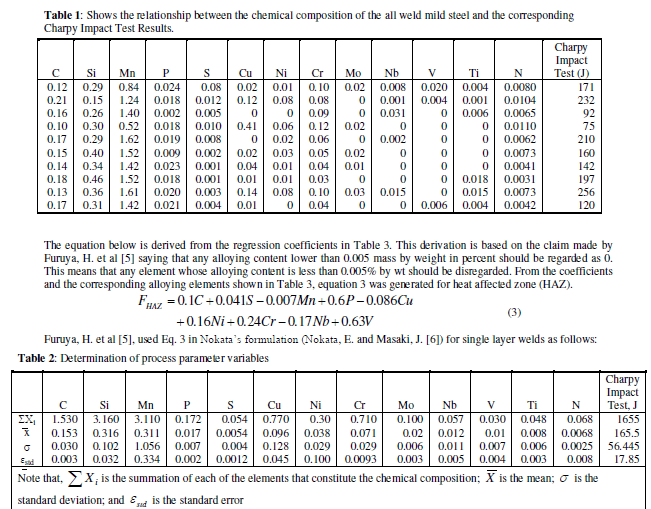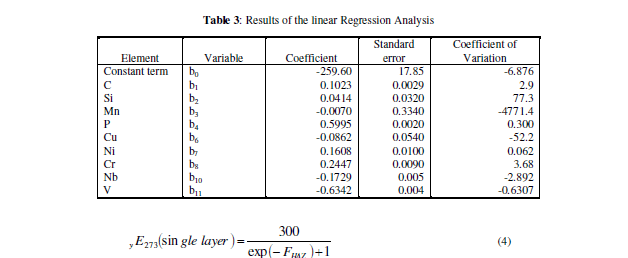ISSN ONLINE(2319-8753)PRINT(2347-6710)
ISSN ONLINE(2319-8753)PRINT(2347-6710)
C. O. Izelu1, B. U. Oreko2, B. A. Edward3
|
| Related article at Pubmed, Scholar Google |
Visit for more related articles at International Journal of Innovative Research in Science, Engineering and Technology
This research work investigates the influence of alloying elements on Heat Affected Zone (HAZ) toughness of welded mild steel joints by identifying the alloying elements and experimentally determining their influence on the strength property of the weld. The ten V- notch impact test specimens made from all weld metal were used to conduct Charpy impact energy test. The chemical compositions of each of the all weld metals were determined. A relationship was established between the chemical compositions and their Charpy impact energy absorbed. The significance of alloying elements on the impact of the absorbed energy is explained by the theory of coefficient of variation. Small coefficient of variation means that the element considered is expected to have a high reliability. The coefficient of variation calculated and presented shows that Si, Cu and Mn have low reliability in term of toughness since the coefficient of variation in these elements is high (positive or negative). Also Mn is less reliable than Si. The implication of this is that the increase in the addition of Mn alloying elements would deteriorate the toughness profile of the weld as well as its Heat Affected Zones (HAZ). Other alloying elements such as C, P, Ni, Cr, Nb and V have high reliability; therefore these elements would tend to improve the HAZ toughness.
Keywords |
| Welded Mild Steel Joint, Alloying Elements, Heat Affected Zone Toughness, Charpy Impact Energy Test |
I. INTRODUCTION |
| With modern technological advancement, more structural materials are designed to carry even heavier loads. Many structural parts need to be welded and the discontinuous parts of these structural materials need to measure up to the standard designed to carry these loads. The strength and toughness of the weld becomes a determining factor as to the sustainability of the project in term of structural integrity, hence the need for steel material that contains the required proportion of alloying elements. |
| Alloying elements are both non metallic and metallic additive in minute proportions to a major metal, such as iron with the main objective of increasing the working strength of the major metal, so as to be able to sustain its designed load and life. This claim is supported by the arguments made by Cho, G. S. et al [1] that alloying elements when added to ductile cast iron, strengthen and toughen it. Morrison, W. B. [2] was of the opinion that micro-alloys can cause major strength and toughness improvements. The proportion of each alloying elements added to the molten metal, in this case, steel is of great significance. Too great or small a proportion of an alloying element can affect the main elements positively or negatively. The amount of alloying elements to be added to main elements depends on the final mechanical property the manufacturer intends to obtain. This alteration in the proportions of the alloying elements would certainly affect the chemical composition and micro structural arrangement of the alloyed base metal. |
| Wheeler, B. D. [3] was of the opinion that steel is a malleable alloy of iron and carbon containing a significant quantity of manganese. Alloy steel, according to him is a material that owes its properties due to some elements or combination of elements other than carbon. The utilization of mild steel for structural work cannot be over-emphasized. Therefore, the need to study effects of alloying elements on the base metal, with the aim of increasing the strength and toughness of these steels materials and in order to satisfy design consideration, become important. In this study, the role of the alloying elements in improving the strength of steel welds was investigated. |
II. EXPERIMENTAL METHODOLOGY |
| The mild steel weld metal compositions were used to make all weld deposits which were machined into the impact test specimens. |
| A material that exhibits good tensile strength properties may not be able to withstand sudden loading. Notched bar impact test measured the toughness of the specimen i.e. the ability to absorb energy. The Avery Impact Testing Machine was used. It consists of 875mm long pendulum carrying the striker head (hammer) and connects to the drive arm which pushed the pointer around the scale. The pointer and scale indicate the energy absorbed when the pendulum is release from the brake lever to strike the Charpy test specimen rigidly fixed in position on the Anvil in the vertical axis of the notch.A Charpy V – notch specimen is placed across parallel jaws in the machine. In the impact test, a heavy pendulum release from a known height strikes the sample on its downward swing and fractured it. Knowing the mass of the pendulum and the difference between its initials and final heights, the energy absorbed by the fracture can be measured (Achebo, J. I. [4]). The Avery Impact Testing Machine was used following the procedure explained hereunder. |
| 1. Impact test specimens with standard dimension of 10 mm x 10 mm x 55 mm were prepared from the all weld metal deposits. |
| 2. Impact test were performed on the specimen using the Avery Dennison Charpy – Izod Impact Testing Machine |
| 3. The impact test results which indicated the energy absorbed as the specimen fracture were read off the scale (Achebo, J. I. [4]) |
 |
III. RESULTS AND DISCUSSION |
| Mild steel electrodes were used to make all weld deposits on mild steel material, machined with lathe and polished with a 1.0 μm and then 0.05 μm emery cloth. The 10 machine polished specimens were analyzed using the weld composition microscope. The results are shown in Table 1. For easy calculation of the standard error and coefficient of variance, Table 1 was used to create Table 2, which shows the process parameters determination. The values of regression coefficient in Table 3 were obtained from the Regression Analysis of the data shown in Table 1 |
 |
 |
| Note that, the term yE273 (single layer) means the absorbed energy of the single layer welded joints in the Charpy impact test at 273K on the Joule Scale. |
| In the V- notch impact test, ten specimens made from all weld metal were used to conduct Charpy impact energy test. The chemical composition of each of the 10 all weld metals were also determined. A relationship was drawn between the chemical compositions and their charpy impact energy absorbed. The significance of alloying elements on the impact of the absorbed energy is explained by the theory of coefficient of variation. From Furuya, H. et al [5] findings, a small coefficient of variation means that the element considered is expected to have a high reliability. The coefficient of variation calculated and presented in Table 3 shows that Si, Cu and Mn have low reliability since the coefficient of variation in these elements is high (positive or negative). The low reliability is expected to have occurred as a result of the increased hardness nature of the steel plates. |
| The hardness could be caused by weld brittleness, which is as a result of the oxygen in-take that has saturated the weld. However, Mn is less reliably than Si. The implication of this is that the increase in the addition of Mn in the alloying elements would deteriorate the toughness profile of the weld as well as its Heat Affected Zones (HAZ). However, other alloying elements such as C, P, Ni, Cr, Nb and V have high reliability; therefore these elements would tend to improve the HAZ toughness with the increase in their contents. Alloying elements Nb and V have significance impact on toughness of the weld. However, if the content of Nb exceeds 0.031% by weight and V exceeds 0.02% by weight, which is the maximum value of their alloying contents expected to be found inside the welds considering the characteristics of the welding processes there is possibility that it may deteriorate the HAZ toughness of the welds. Alloying elements Ni and P show that the introduction of minutes content into the weld chemical composition may have a great effect on the toughness improvement of the weld, therefore, lower values of these elements are suggested, which are 0.01% by weight and 0.002% by weight respectively. From the analysis, it is seen that C, O, Ni, Cr, Nb and V, amongst others, have relatively higher reliability, therefore, it is suggested that the weld formulation should contain these six elements in order to improve the quality of weld for engineering applications. |
IV. CONCLUSION |
| From the study, parameters responsible for mild steel strength, design to meet or sustain expected loads are the alloying elements which are metallic and non metallic additives used to increase the strength of the original metal. This is as a result of the fact that most metals in their original form are soft and cannot withstand the force or load for engineering applications. |
| In this study, the contributions made by the alloying elements on the mechanical properties of the weld metal were analyzed using Regression analysis. Six elements C, P, Ni, Cr, Nb and V have been identified to constitute the chemical composition of the weld that is expected to achieve the required impact strength. |
References |
|